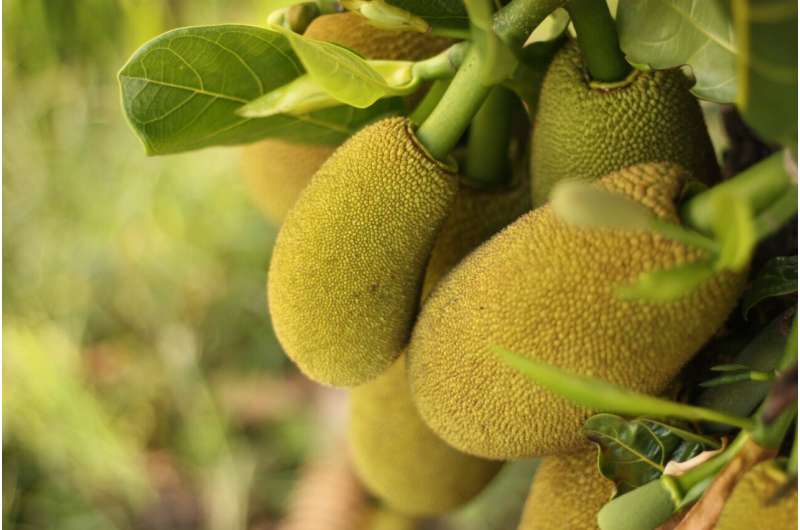Making jackfruit jump off the shelves

Australian jackfruit is a tropical treasure: a fruit rich in vitamins, minerals and many phytochemicals that are known to have positive health benefits, and it is incredibly versatile in its culinary uses.
When ripe, its sweet fruit segments are akin to the tropical tastes of banana, mango and pineapple and when unripe, its stringy texture is known to be a healthy meat substitute increasingly popular in western cuisine.
And yet, jackfruit remains an underutilized food source in Australia perhaps due to its spiky exterior, rock hard rind and cumbersome size; a jackfruit can weigh up to 50 kilos and is the world's largest tree-grown fruit.
With transportation and labor costs high in Australia, jackfruit production which is predominantly located in the Northern Territory and Far North Queensland, has plateaued in recent years. However, new research has indicated that the industry has the potential to grow significantly with forecasts of production of $5–$10 million by 2025.
In a project funded by AgriFutures Australia as part of its Emerging Industries Program and in conjunction with the Northern Territory Government's Department of Industry, Tourism and Trade, Monash Food Innovation were commissioned to pull jackfruit apart and explore how the industry can drive more consumer demand for the versatile but largely unfamiliar fruit— to find ways to process jackfruit into ready-to-eat products and ingredients and make jackfruit jump off the supermarket shelves.
"Results suggest that Australians are interested in consuming more jackfruit products, due to its high nutritional value and flavor, but a big barrier is the availability of products outside growing regions in northern Australia. There are many opportunities for the Australian jackfruit market to capitalize on the development of new products and to help grow the emerging industry," says lead researcher, Dr. Leonie van 't Hag from the Department of Chemical and Biological Engineering at Monash University.
The multidisciplinary project team from Monash Food Innovation, the Department of Chemical and Biological Engineering and the Monash Business School used innovation methodologies to develop and evaluate new jackfruit products.
Their findings have now been released in a report, "Processing jackfruit into ready-to-eat products and ingredients," published by AgriFutures Australia which outlines the market opportunities for the industry to grow in Australia.
Over one thousand consumers were engaged in testing and evaluating jackfruit to determine new consumer applications, the potential to utilize greener fruit with the skin and seeds as by-product, and diverse processing applications for different stages of the fruit's maturity. This included sensory evaluations, based on sense of taste, smell, texture/feel and sight.
Further research has also helped understand how crop genetics and market capitalization can grow the jackfruit industry and overcome the current supply chain challenges.
Dr. Leonie van 't Hag from the Department of Chemical and Biological Engineering says the results showed that processed jackfruit could be introduced to consumers through familiar formats and new ideas including snacking, treats, meat alternatives, home cooking and restaurants, as well as quick and easy meals.
"Jackfruit has so many benefits; it is high in fiber, minerals such as calcium, phosphorus and magnesium, and it is a good source of vitamin A, B1 and B2," Dr. van 't Hag says.
"Compared to other tropical fruits the protein content in the seed and young fruit is high. It is a good source of Lysine, an amino acid that vegetarians and vegans can struggle to obtain in their diet. Research also suggests that jackfruit has many classes of phytochemicals that have anti-cancer, anti-hypertensive, anti-ulcer and anti-aging properties."
Jackfruit grows abundantly in South and South East Asia but unless it gets processed it doesn't have much market value due to the large size of the fruits. This is replicated in northern Australia where the costs of labor and transport are high.
"Jackfruit is a nutritious fruit and it is evident that novel processing techniques could appeal to consumers and ensure the industry can maximize its value for production," says Dr. Olivia Reynolds from Agrifutures.
The estimated gross value of production of the Australian jackfruit industry is currently $2.6 million. The research has found that if a quarter of this supply was diverted to processing, an estimated $3.3 million of value would be added each year from existing production.
The Department of Industry, Tourism and Trade's Director of Plant Industries, Dr. Muhammad Sohail Mazhar, says there are opportunities to increase the demand for jackfruit and grow the industry over the next decade.
"Through this research project, we aimed to support Northern Territory growers who are planting clonal varieties of jackfruit suitable for processing over the next 5 years. As these trees reach maturity over the next 45 years, there will be an increase in demand for jackfruit species which can be diverted into processing activities. This has the potential to substantially boost the jackfruit industry in the Northern Territory and Australia."
More information: Processing jackfruit into ready-to-eat products and ingredients: www.agrifutures.com.au/product … cts-and-ingredients/
Provided by Monash University




















